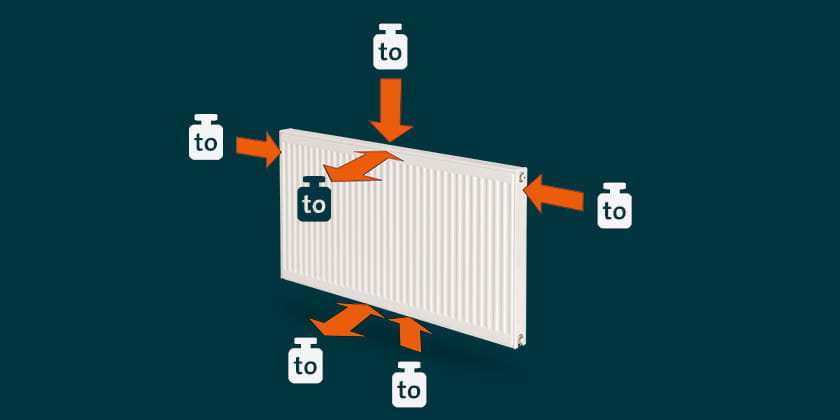- Work smarter
- Product info
- Radiators
The important role of radiator brackets in safe installations
Choosing the right radiator that provides the right heat output is of course important. Equally important is a safe installation of that radiator. For this purpose, there is the VDI 6036 guideline. This helps planners and installers take into account any forces acting on a radiator during both intended and unintended use. It also helps to prevent accidents such as have happened in the past due to falling radiators for which the installer is ultimately held responsible. For requirement class 2 and 3 defined in the VDI 6036 guideline, and in some cases for class 4, we offer suitable radiator brackets so that safety can always come first.
VDI guidelines
VDI guidelines have been created to offer support in technical challenges as well as set quality standards that reflect the current state of art. VDI has its origins in Germany and stands for ‘Verein Deutscher Ingenieure’. The VDI guidelines give professionals a safety net and offer assurance that they are working with a standard that is recognised within the EU. Although the VDI guidelines are basically recommendations and there is no obligation to apply them, experience has shown that in the event of a legal dispute, any court will be guided by the current standards and guidelines.VDI 6063 & radiator brackets
The VDI guideline 6036 provides a decision-making basis for the selection of suitable fastening systems for radiators, such as radiator wall brackets or floor brackets. The guideline takes into account any additional loads that are likely to be encountered and defines 3 requirement classes depending on the application. These classes refer to the required load-bearing capacity of the radiator fixing systems depending on the application.

The VDI 6036 guideline helps planners and installers take into account any forces acting on a radiator during both intended and unintended use.
From civilised to heavy duty usage
The 3 requirement classes stipulate the requirements for radiator fixings in different circumstances. This allows for the radiator brackets to be selected and dimensioned in such a way that they ensure a secure hold of the radiator in the mounting, even in the event of unforeseeable misuse. A heavy object such as a filled radiator can certainly pose a potential hazard. If the radiator falls it can cause both personal injury and water damage. Therefore, it’s important that the radiator fixing is done correctly.Improper use of radiators occurs frequently in everyday life. They are, for example, used as seats, climbing aids or shelves for heavy objects. As a result of such use, someone can be injured, or the heating water can cause costly damage to the building and furnishings. The anchoring of the radiator also needs to withstand various collisions with, for example, children’s vehicles, wheelchairs and other equipment found in private households, hospitals, etc.
Public areas are an entirely different chapter as deliberate destruction can be expected. At the end of the scale are extreme forms of vandalism, such as occasionally occur in psychiatric wards and prisons. Safe radiator fixing is therefore a broad field. Moreover, if something happens, the question of liability is also on the agenda.
3 requirement classes for radiator brackets
Normal to more stringent requirements are covered by requirement class 2. This applies to living areas, office spaces and publicly accessible areas such as sales rooms, stairwells and hotel rooms. Careless use can easily occur here.Requirement class 3 is more demanding as it applies to the high requirements that can occur in classrooms and escape routes. Here radiators are often intentionally used as seating or have to withstand panic situations in case of escape routes. Class 4 is reserved for very high requirements and special loads, such as can be expected in prisons or psychiatric wards. Here the highest fastening stability must be guaranteed.
Fitting radiator brackets for every situation
For class 2, 3 and partly class 4 we offer corresponding radiator wall brackets and floor brackets. Our range is structured to simplify the work of planners and installers in standard cases. Almost all our radiators which are supplied with radiator brackets comply with at least requirement class 2.Class 3 describes higher requirements for applications such as escape routes, schools, youth centres, places of assembly, railway stations and barracks. Requirement class 4 is a more freely defined class that is specified by the client. There is no ready-made bracket in this case. Here we recommend consultation with the building owner first to determine the precise requirements and discuss any exceptions that might be applicable.
VDI 6036 requires great care to be taken in the selection of suitable mounting systems in order to avoid accidents and damage. In addition to the mounting brackets, the wall condition and its load-bearing capacity must also be checked.
Don’t hesitate to contact us if you have any more questions on this subject or need help finding the right radiator brackets for your particular project. We will be happy to assist.
Get in touch

